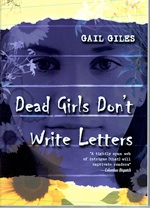How I Wrote It
This novel started with a title. Somewhere I read a phrase about getting letters from the dead. But the dead don’t write letters. Short trip to DEAD GIRLS DON”T WRITE LETTERS. I had a main character in mind for a book—a main character that doesn’t fit with her family. Not just believes she doesn’t—she is the real deal square peg in the round hole of her family. I decided to combine these thoughts. Now, a girl like this, one that gets no emotional nourishment from her family would be a lot of things and likable might not be one of them. How do I make an unlikable main character someone a reader wants to turn pages for? What if she follows all the rules of her family—and still doesn't get the love she needs? And make her funny. Sarcastically funny, is the only way that can be realistic. Now, if she can’t fit with her family, why doesn’t she leave? And that’s where the dead girl entered. The main character can’t leave because her family is falling apart—because their favorite child recently died. And now, I had enough to start drafting a story. Asking myself questions, letting my characters answer them.
I love books that are head trips. Books that make you wonder did it happen or not. If you haven’t seen it, rent the movie GASLIGHT. And I like things that happen in a concentrated space and time. So everything in this book happens in a house and most of it happens in less than nine hours. What fun to write.
This book once had a completely different ending. I never liked the ending, but didn’t think the one I preferred would fly with an editor. What a great thing when my editor called and said, love the book, love the characters, hate the ending. So over the phone, I told the editor my original idea and she said—“it gives me goosebumps. Write it.”
Now that’s like someone handing you the keys to the castle.





